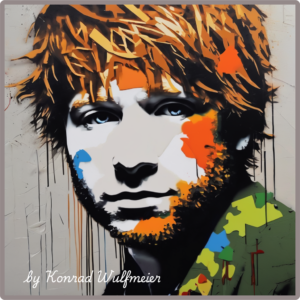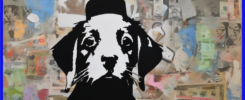Konrad Wulfmeier AI Artist: Creator Human, Tool AI – The Journey of Modern Art
The Lifecycle of an Artwork: From Inspiration to Provenance in AI Art
The journey of an artwork begins, much like a human life, with its birth: the moment of creation. Traditionally, we think of the artist wielding brushes, paint, and canvas. However, with the growing fusion of art and technology—particularly through Artificial Intelligence (AI)—a new dynamic emerges, challenging the very definition of art. Today, an artwork may not solely be crafted by human hands but can result from a collaboration between human and machine. This evolution raises a fascinating question: Does an AI-generated artwork also have a lifecycle or provenance, as traditional works do?
The Creation of an Artwork: Inspiration, Craftsmanship, and the Role of AI
Every artwork begins with an idea, an inspiration. Artists observe the world around them, interpret it through their unique perspective, and translate this vision into a piece. With the advent of AI art, this creative process is transforming. Artists, including myself, now use AI as a tool to bring visions to life. While inspiration remains the starting point, AI opens doors to unprecedented forms, colors, and techniques.
translate this vision into a piece. With the advent of AI art, this creative process is transforming. Artists, including myself, now use AI as a tool to bring visions to life. While inspiration remains the starting point, AI opens doors to unprecedented forms, colors, and techniques.
Craftsmanship, once rooted solely in mastering physical techniques like painting or sculpting, has expanded. Today, artists must master the ability to guide AI systems toward desired results. Here, art galleries play a central role by providing platforms where AI art is exhibited and interpreted. Despite the use of AI, the artist’s signature remains evident, as they define inputs, make creative choices, and finalize results. AI serves as an enabler of the artistic vision—not its replacement.
The Uniqueness of Art: Bridging Machine and Human
Even with AI, the artist’s creative fingerprint is a defining element. Artists working with AI develop a distinctive style through the choice of prompts and interpretation of outputs. While AI offers limitless possibilities, the direction and final form of the artwork are shaped by the artist.
For example, in my own practice, which I call QuantumNatur-Art, I merge elements of nature with the infinite potential of AI. The resulting works, though calculated by machines, are imbued with my intentions and curation, making them unmistakably personal.
The Lifecycle of an Artwork: From Creation to Provenance
Traditionally, an artwork’s lifecycle is tied to its provenance—the documentation of its origins, ownership, and exhibitions. A work passes through various stages, from galleries to private collections to auction houses. Each stage adds a layer to its history, shaping its value and significance.
In the realm of AI art, new questions arise: How can the provenance of a digital or AI-generated artwork be traced? If an artwork is crafted not by the artist’s hands but by algorithms, its authenticity and origin become more complex. Yet, there are ways to document this lifecycle.
The Provenance of AI Art: Challenges and Solutions
Documenting the provenance of AI-generated art requires innovative approaches. One increasingly popular solution is the use of blockchain technology. Embedding data within the artwork ensures a tamper-proof, transparent record of its creation, ownership, and exhibitions.
Another approach involves integrating detailed metadata into digital works. This metadata can reveal which algorithms were used, the input parameters, and how outputs were curated. Combined with traditional documentation, these techniques provide a comprehensive lifecycle for AI artworks.
Human-Machine Collaboration: Who Is the Creator?
A central question in AI art provenance is that of authorship. When an artwork is co-created by human and machine, who is the true creator? The artist who programs the AI and defines its inputs? The programmer who developed the AI? Or the AI itself, which generates the work?
This is not just a theoretical issue but one with legal and ethical implications. In my practice, I consider myself the primary creator, even though AI performs a significant part of the process. I determine the vision, interpret the outputs, and shape the final piece. AI is a tool that helps me realize my vision—nothing more, nothing less.
AI Art in the Gallery: New Avenues for Presentation
Galleries are adapting to the rise of AI art. While traditional artworks are often displayed physically, digital platforms offer new ways to showcase art. Online galleries and virtual exhibitions are becoming increasingly popular, especially for AI-generated works.
These digital spaces allow audiences to experience art interactively and immersively, often in real-time. However, tracing the lifecycle of an artwork in a virtual gallery poses new challenges. Blockchain plays a critical role here by transparently tracking the transfer and ownership of digital works.
Uniqueness in Your Art: Personal Signature and AI
A key challenge in AI art is developing a personal signature. Though AI acts as a creative partner, it is up to the artist to individualize the work and give it a distinct identity. The choice of prompts—whether in text or visual references—and the interpretation of outputs are crucial to an artwork’s uniqueness.
In my work, I use AI not as a replacement for creativity but as an extension of it. Every decision—from selecting parameters to curating outputs—is deliberate, resulting in a personal signature that remains evident, even in AI-generated art.
outputs—is deliberate, resulting in a personal signature that remains evident, even in AI-generated art.
The Future of AI Art: New Eras and Challenges
AI art is still in its infancy. Like any new artistic era, it challenges our understanding of art, creativity, and authorship. But with these challenges come new opportunities. Artists who embrace AI and technology can push boundaries that were once unimaginable.
The future of art lies in the fusion of technology and human creativity. While AI’s role will continue to grow, human intention and vision will remain central. Galleries, too, will need to evolve to accommodate these new forms of expression.
What Will Humanity Achieve with Its Creativity?
The collaboration between human and machine is unlocking new horizons for the art world. As AI becomes more powerful, human creativity remains the heart of every artistic endeavor. In a world where the lines between technology and art blur, one question lingers: What will humanity, with its boundless imagination and capabilities, achieve next?
Machine or Masterpiece? The Origins of AI Art
Creator Human, Tool AI: The Journey of Modern Art
QuantumNatur-Art: A New Era in Artistic Provenance
From Inspiration to Algorithmic Art: An Artwork’s Lifecycle
How AI Art Writes Its Own History
The Digital Signature: Provenance in the Age of AI
Personal Signatures: How AI Artists Shape Their Works
The Lifecycle of a Digital Artwork: Between Algorithm and Creativity
From Canvas to Code: How Provenance Is Changing in Art
AI Meets Creativity: The Journey of Digital Art
Art AI and Galleries: The Evolution of the Artistic Narrative
Provenance in AI Art: Who Is the True Creator?
The Story of AI Art: From Idea to Exhibition
© 2025 Konrad Wulfmeier | Master Code™ – QuantumNature-Art

